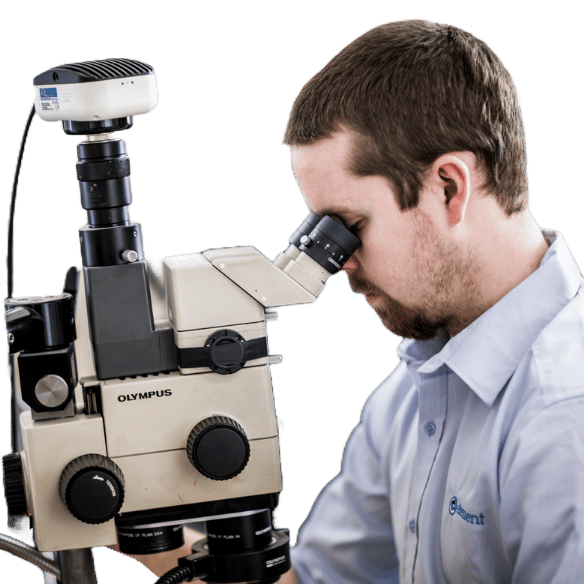Sulfide Stress Cracking (SSC) Testing Services
Sulfide Stress Cracking (SSC) testing helps evaluate your materials and detect danger early, preventing sour service pipeline failures. Often occurring without warning and undetectable without specialized inspection methods, this dangerous type of corrosion creates critical technical challenges for the Oil & Gas and Petrochemical industries. Trust Element’s collaborative global expert network for cost-effective, solutions – fully compliant with NACE TM0177 standards – to ensure your infrastructure’s reliability.

What is Sulfide Stress Cracking (SSC) Testing at Element?
As a form of hydrogen stress cracking, Sulfide Stress Cracking (SSC) is a cracking mechanism in pipelines, facilities piping and any equipment that encounters sour (wet H2S) service conditions. It is characterized as the cracking of a metal when subjected to the combined effects of tensile stress and corrosion in the presence of water and hydrogen sulfide.
At Element, we prioritize your asset protection, offering expert-led assessments and timely, comprehensive solutions to help evaluate your materials and detect danger at an early stage, preventing failure of sour service pipelines. Recognizing the urgent need to assess material sustainability, our experts proactively identify and mitigate the evolving risks.

What Can Element Offer You For SCC Testing?
Key Tests Offered
Key Tests Offered
Element's comprehensive suite of SSC testing services focuses on early detection and prevention of sulfide stress cracking in sour service conditions. We offer specialized testing compliant with NACE MR0175/ISO 15156 standards, evaluating materials under both standard and specific field conditions to ensure infrastructure reliability.
- Stress-oriented hydrogen-induced cracking (SOHIC)
- Sour Service applications – NACE TM0177, NACE TM0316, EFC 16 and EFC 17
- NDT testing and inspection, including ultrasonic inspection and magnetic particle testing
- Four Point bend test
- C-ring test
- In-situ hydrogen permeation monitoring
- Bore and out of diameter (OD) exposure testing
Residual Stress Full Ring Testing (FRT) / Ovalisation Test
Offered on pipe material from 2-inch (50 mm) up to 60 inch (1524 mm) diameter according to BS 8701 (formally OTI 95-635). Tests can be conducted on parent material or welded pipe (SAW/seam, spiral and/or girth) with the corrosive environment in contact with the bore or out of diameter (OD). The full pipe section is loaded to the required stress and exposed for a 30-day period after which the sample is examined for evidence of SSC, HIC, SOHIC and Soft-Zone Cracking. The inclusion of in-situ ultrasonic inspection and hydrogen permeation during the test enhances the comprehensiveness of the testing approach.
Element-developed Test Method: Axially Loaded Full Ring Test (AFRT)
Element has developed the Axially Loaded Full Ring Test (AFRT) method, specifically designed for SSC testing of parent welded pipes under high axial loads in service. This innovative approach includes a 30-day exposure period and examination for evidence of various forms of cracking, accompanied by in-situ ultrasonic inspection and hydrogen permeation.
Components And Products We Test
Components And Products We Test
We provide comprehensive testing for critical oil and gas infrastructure components, from small-scale piping to large diameter pipelines. Our expertise spans testing of carbon steels, low-alloy steels, and Corrosion Resistant Alloys (CRAs), with specialized capabilities for both parent material and welded pipes ranging from 2 inch (50mm) to 60 inch (1524mm) diameter.
- Parent and welded pipe (SAW/seam, spiral and/or girth)
- Well components
- Facilities piping
- Exploration and refining equipment
- Full pipe sections
Methods And Solutions Offered
Methods And Solutions Offered
We evaluate the performance of carbon steel, low alloy steel and Corrosion Resistant Alloys (CRAs) for sour service applications using the following methods:
NACE TM0177
- Method A – Smooth Tensile Test
- Method B – Bent-Beam Test
- Method C – C-Ring Test
- Method D – Double-Cantilever-Beam (DCB) Test
NACE TM0316
- Four Point Bend Test
EFC 16
- Carbon and low alloy steel test methods
EFC 17
- CRA test methods
Cutting-Edge Equipment We Use
Cutting-Edge Equipment We Use
Our state-of-the-art laboratory facilities enable simulation and evaluation under both standard sour conditions and specific field conditions. We assess your materials for SSC resistance in HPHP conditions and exposure to corrosive substances using advanced equipment.
Which Labs Offer This Service
Which Labs Offer This Service
Our team operates from ISO 17025-accredited energy testing hubs across the world, providing global access to our expert capabilities and supporting your diverse geographical operations. Find out where your nearest energy testing hub is on our Locations Page.
Standards we test to and components we test
NACE standards
- NACE MR0175
- NACE TM0177
- NACE TM0316
EFC standards
- EFC 16
- EFC 17
ISO 15156
BS 8701 (formerly OTI 95-635)
Pipeline Components
- Pipe material (2" to 60" diameter)
- Parent material pipes SAW/seam welded pipes
- Spiral welded pipes
- Girth welded pipes
- Bore sections
- Full pipe sections
Material Types
- Carbon steels
- Low-alloy steels
- Corrosion Resistant Alloys (CRAs)
Facility Infrastructure
- Facilities piping
- Well components
- Exploration equipment
- Refining equipment
Your Challenges, Our Solutions
Unexpected Pipeline Failure Risk
Complex Regulatory Compliance Demands
Harsh Environment Performance Uncertainty
Time-Critical Testing Requirements
Element Experts at your service
Why Choose Element

Expertise in Harsh Environments
Non-Destructive Testing (NDT) Excellence
Collaborative Risk Management
Tailored Testing for Diverse Industries
10+years
60”maximum
23global facilities
600+scientists & engineers

Frequently asked questions
Do you offer diverse material coverage?
Yes, we offer comprehensive materials testing for pipelines, well components and exploration and refining equipment, including carbon steels, low-alloy steels and Corrosion Resistant Alloys (CRAs).
Do you work within tight time and budget constraints?
Yes, our timely and cost-effective approach involves efficient testing processes to support your tight deadlines and budget constraints.
Do you also offer SSC advice and guidance?
Yes, our corrosion experts provide recommendations for materials selection, coatings, and other measures to enhance SSC resistance and mitigate challenges, supporting your long-term asset protection strategy.
What is the difference between SSC and SCC?
While both Sulfide Stress Cracking (SSC) and Stress Corrosion Cracking (SCC) are forms of environmentally caused cracking of metals, they differ in the specific conditions and mechanisms involved. Sulfide Stress Cracking occurs in materials exposed to sour environments with hydrogen sulfide (H2S) and involves the combined action of tensile stress with H2S-induced corrosion, leading to cracking in susceptible materials – most often high strength steels. By contrast, SCC can occur in various other environments, not just those containing sulfides--- like particularly acidic or alkaline environments. The cracking is caused by the combination of tensile stress and corrosion caused by whichever type of environment the material is in.
Speak to our team of experts

Explore our global network of labs and find your nearest location
VIEW ALL LOCATIONSRelated services

Oil and Gas Corrosion Testing Services
Element's oil and gas corrosion testing identifies material vulnerabilities, supports compliance, and prevents failures through advanced simulation, predictive modeling, and testing in extreme environments.

ASTM F519 Hydrogen Embrittlement (HE) Testing Services
Element's ASTM F519 hydrogen embrittlement testing evaluates material performance under tensile stress, identifying vulnerabilities in high-strength steels and alloys to prevent failures in aerospace, automotive, and energy applications.

Hydrogen Induced Cracking (HIC) Testing
Prevent critical equipment failure with our fast-turnaround Hydrogen Induced Cracking Testing. Expert NACE-compliant analysis ensures your oil & gas components are safe for sour service environments.

Stress Corrosion Cracking (SCC) Testing
Element's stress corrosion cracking testing identifies material vulnerabilities early, preventing sudden failures. Our specialized analysis replicates real-world conditions to enhance reliability, safety, and compliance across critical industries. Learn More.

Polymer Chemical Resistance Testing
Polymer chemical resistance testing evaluates material compatibility with fluids to prevent failure. Element delivers precise data on degradation, swelling, and durability, helping ensure long-term performance in demanding conditions.


